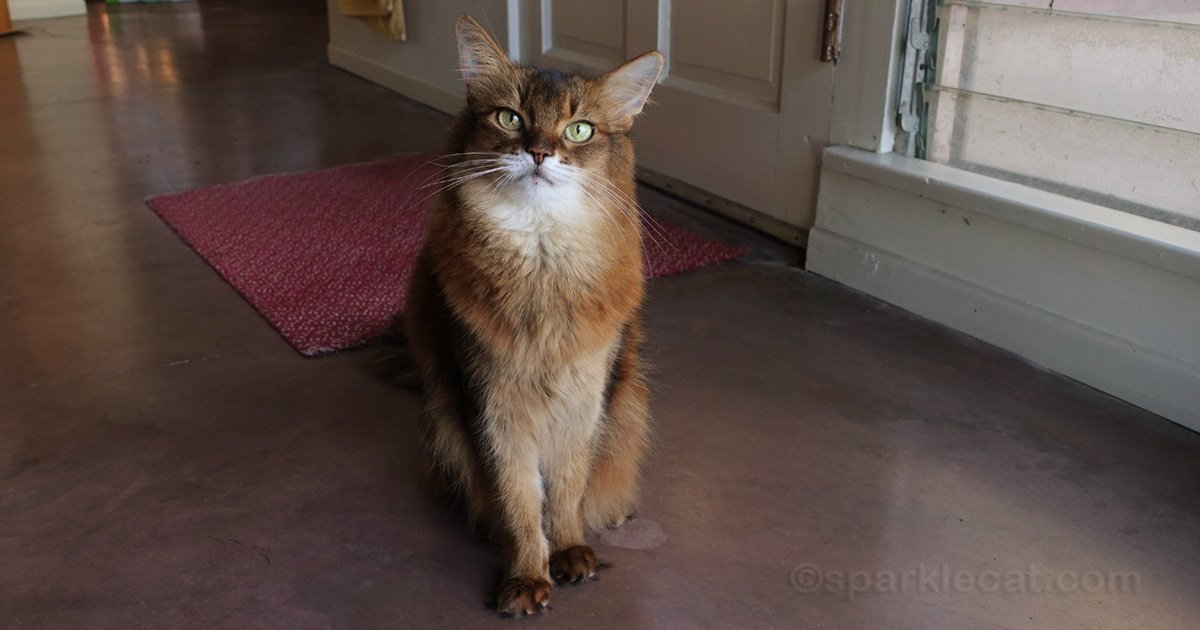Because I started off very young with nail trims, my human has never had a problem clipping my claws. Sadly, that’s not the case with many cats and their humans. It’s a struggle that causes a lot of stress, and perhaps some bloodletting. Some people have their veterinarians do it, which still is a stressor for the cat. There has to be an easier way. And according to PhD student and researcher Jennifer Link, there is.
Why Trim Your Cat’s Nails Anyway?
Because my claws are so blunted, my human forgets how sharp cat claws can be! But when we hang out with the peach kitty she remembers. He’s seen me reach for treats, and he tries it occasionally with my human. But his claws are needle-sharp, and he’s unintentionally given her a few finger punctures. Which causes her to draw back her hand, which scares him. Then she has to get him to trust her again.



As an outdoor cat, the peach kitty needs those talons as protection, and for hunting (although he gets fed well by our neighbor). But your indoor cat’s claws can cause damage! To your furniture, your rugs and your curtains — and most importantly, to you. If they use you as a launching pad, those claws digging into you can hurt! If you need to grab them suddenly, to keep them from jumping out a window, for example, flailing limbs can slice you up. Even though your cat didn’t mean to hurt you, he can, very easily.
But indoor cats still need their claws. They are part of their anatomy, just the same as human fingers. To keep their limbs healthy and in shape, they need those claws for stretching and exercise. They just don’t need to be all that sharp!
Why Cats Hate Claw Trims
One thing cats hate more than anything else is to be restrained or held against their will. As an animal that is both predator and prey, they instinctively treat it like a threat. It’s scary for a cat to lose control of their ability to move freely, even when they are being restrained by a loved one. (Imagine how we must feel when a stranger, like a vet tech, is doing the restraining! You’d be terrified too.)
And that’s the problem with claw trims. They involve restraining your cat, and forcing them to be still while you focus on trimming the claw tips without cutting into the quick — the area where the nerves and blood supply are. And the more your cat struggles, the tighter you want to hold them. And the more the cat wants to get away. No wonder everybody, human and kitty, dislike nail trims!
Cooperative Care Instead of Restraint
Jennifer Link is part of the UC Davis Animal Welfare Epi Lab. She has been working with shelter cats for several months, socializing them and working on new protocols to reduce the stress of claw trimming. One thing she found effective involves cooperative care, in which the cat decides how much they want to interact with the handler.
For her work at the shelter, Link uses a mat. She sits by the mat, and only interacts with the cat while they’re on the mat. When they step off, that’s the cue that they’ve had enough.
At first, the cat is tempted onto the mat through treats and affection. If they put their front paws on the mat, they get rewarded and that’s the first step. She builds trust over time, touching the cat’s legs, and then paws. Any time the cat resists handling or steps off the mat, she stops. The interaction is totally the cat’s decision.
Eventually, if the cat lets her gently squeeze their paw, she will snip off just one claw tip. And she keeps building from there, letting the cat’s trust be her guide. Eventually she works up to a full claw trim.
Why Cooperative Care Works
When a cat realizes they are in control and won’t be handled or restrained against their will, they become more agreeable. A bond of trust builds.
How long this takes depends on the cat — where they came from, their age, their past interactions with people. It takes a lot of patience on the human side of things, and also a lot of awareness about how the cat is reacting. In fact, the more the person pays attention to the cat’s behavior, the better the socialization and desensitization will go.
Can Cooperative Care Work for My Cat?
While this approach seems to fully rely on the cat’s decisions about interaction, the truth is that it actually relies on the human. Sometimes it’s hard to resist trying to make things go faster, or to just grab the cat and have them do what you want. But that will cause the process to go backwards. If you hang in there, however, you wind up creating a very special bond with your cat that goes beyond just a nail trim.



So try the mat process for yourself, and see how your cat reacts! At the very least it will be an interesting experiment.
If you want to know a little more about Link’s work, check out this article at the UC Davis website.
Does your cat let you trim their claws? Do you have any special techniques that you use? Let’s discuss it in the comments.
You may also want to check out these posts about cats, claws, and bonding:


